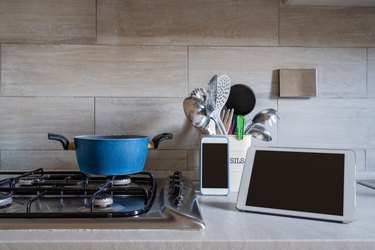
Plastic is an undeniably useful household material. Not only is it super strong, but it's also easy to use in manufacturing. It's no wonder that plastic makes up a huge variety of items around the home, from children's toys to cookery utensils.
But one of the major strengths of plastic is also one of its weaknesses — its low melting point. According to Seattle Pi, most plastic melts at around 300 degrees Fahrenheit. This allows the plastic to be easily molded into all manner of useful shapes. The problems arise when your finished plastic product reaches this temperature and begins to warp, melt and even burn.
Video of the Day
Video of the Day
Protecting Plastic Utensils
Many kitchen utensils are made out of plastic or have some plastic components. Handles of knives and pans and items such as chopping boards will sometimes be exposed to higher temperatures than they can actually stand. If you have expensive kitchen items with plastic components, it may be pertinent to keep them away from the hob and only use during pre- and post-cooking. This isn't just important in terms of keeping your utensils looking their best — according to the Daily Mail, some plastic utensils can leak harmful gases when they get over a certain temperature.
How to Repair Melted Plastic
No matter how careful you are, though, sometimes damage to your plastic utensils is inevitable. Luckily, there are several ways to fix melted plastic at home. There are a variety of different methods to restore melted plastic. Each begins, though, by thoroughly cleaning the area of any soot and residue using dish detergent and water.
If your plastic is just slightly warped or out of shape, it can be repaired by warming in water. Once it's warm enough to have become slightly malleable, reshape by hand, then place in a bowl of cold water to set the shape. If your damage is more severe, you may need to do a more thorough plastic repair job. First, sand the area to remove any distortions. Clean again with detergent and water. You can then fill in any depressions using an epoxy. Make sure to keep the room ventilated and wear gloves when handling epoxy.
You can purchase plastic epoxy deliberately designed for the job. Allow the epoxy to dry, then sand once more to ensure the area is as smooth as possible. If you want your utensil to look as seamless as possible, you can even use plastic paint over the area to help it blend. You can purchase a range of these from any hardware store. You can even purchase products designed specifically to fix plastic. JML offers portable sheets of malleable plastic fixer that you can use to fill in any holes or melted patches. If you use a specifically designed plastic epoxy, your utensil will be both dishwasher and food safe.
How to Clean Melted Plastic
According to GE Appliances, if you have melted plastic stuck to your hob or oven, you should gently heat it until it softens, then scrape it off using a wooden spatula. If the plastic is more stubborn, soaking it in acetone can help weaken it and allow it to be chipped off.